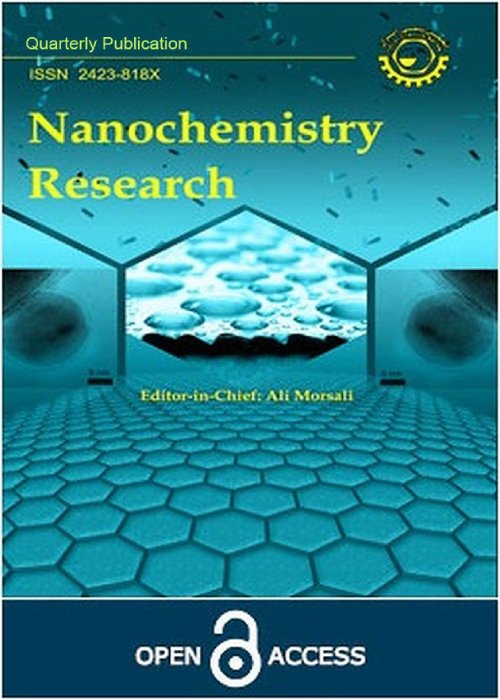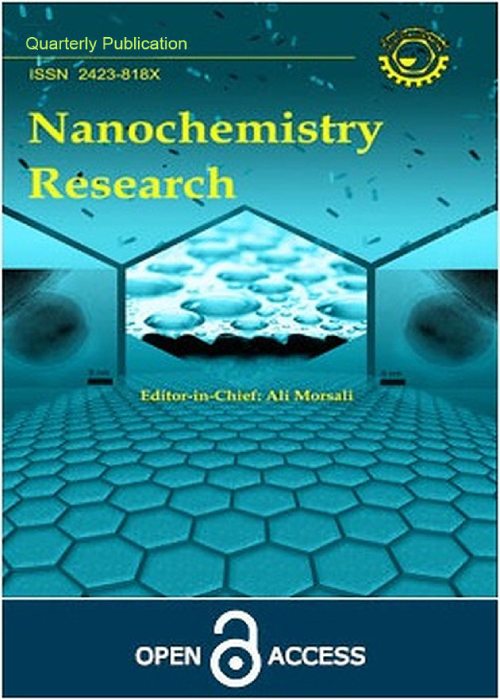فهرست مطالب

Nanochemistry Research
Volume:8 Issue: 3, Summer 2023
- تاریخ انتشار: 1402/04/10
- تعداد عناوین: 8
-
-
Pages 164-172This study presents the preparation and application of a perlite/calcium alginate/single walled carbon nanotubes-Glucose composite for the cumin encapsulation as an essential oil using a simple method. The as-prepared composite was analyzed using Fourier transformed infrared (FTIR), field emission scanning electron microscopy (FESEM), X-ray diffractometer (XRD), dynamic light scattering (DLS), and thermo gravimetric analysis (TGA). The effect of important factors was determined by evaluating pH, cumin concentration, perlite/calcium alginate/single walled carbon nanotubes-Glucose dosage, and time. Based on the data, the high percentage of cumin encapsulation was achieved at low pH. The release profile of cumin was studied at pH=7, and the maximum release was obtained after 48 h. The antibacterial and antifungal properties of cumin-loaded perlite/calcium alginate/single walled carbon nanotubes -Glucose were also evaluated against Candida albicans, Gram negative (Escherichia coli) and Gram positive (Staphylococcus aureus) bacteria, which represented more photogenic detection compared to that of cumin. Finally, this work demonstrates the efficient application of perlite/calcium alginate/single walled carbon nanotubes-Glucose for the encapsulation of cumin and pathogen detection.Keywords: cumin, ·perlite, calcium alginate, SWCNT-Gl, ·Encapsulation, antibacterial, Biomaterial
-
Pages 173-180
Over the last decade, engineering the polymeric vascular grafts has been extensively studied. Various types of polymers have been used in this field such as synthetic polymers, natural polymers, and polymer blends. Synthetic polymers, such as Polycaprolactone (PCL), have displayed improved mechanical specifications compared to natural polymers. Polycaprolactone is biodegradable polyester that can be blended with another synthetic polymer or a natural polymer to yield even greater enhanced mechanical properties. The mechanical properties of artificial blood vessels play an important role while the vessels are attached to the native vessels in the animal body. Furthermore, the artificial blood vessels must be adequately strong to resist frequent blood circulation and related pressure. The most significant advantage of engineered vascular tissue implants is their ability to grow, remodel, rebuild, and respond to injury. This article serves as a review of the fabrication, specifications, and benefits of various kinds of polycaprolactone grafts. The primary focus is on the in vivo implantation of nanofibrous ones for vascular regeneration in large and small animals. First, the subject of the study was thoroughly investigated, then the search was conducted with a combination of index and text terms. Finally, a number of articles, scientific books, patents, manuals, and university theses were selected and studied, and the obtained data were analyzed, categorized, and edited. PCL polymer has been the most sought-after biodegradable polymer for use as a vascular tissue engineering material.
Keywords: polycaprolactone, vascular graft, animal model, Nanofibrous, in vivo -
Pages 181-189
KTiOPO4(KTP)nanoparticles were synthesized using acetic and formic acids as capping agents by the co-precipitation method for the first time. X-Ray diffraction (XRD) and Fourier Transform Infrared (FT-IR) analyses confirmed the formation of the KTP structure with an orthorhombic phase. The effect of capping agents on the structural and morphological properties of obtained KTP nanoparticles was studied. The Biggest grain size(66nm) and lattice strain (0.0056) were obtained using acetic acid and formic acid, respectively. Using acetic and formic acids resulted in the rotation of the crystal lattice and an increase in the grain size. Acetic acid prevented the agglomeration of synthesized KTP nanoparticles after calcination, and resulted in uniform size distribution. Theoretical computations and FE-SEM analysis were used for morphological studies. FE-SEM analysis shows acetic acid results in the spherical form of nanoparticles, and using formic acid leads some nanoparticles ‘morphology to oriented growth. Theoretical computations confirmed these results. The structural energy of the most stable KTP nanostructures obtained using formic acid as a capping agent was ∆E=-202∙6518584 kj⁄mol and ∆E=-196∙613208 kj⁄mol. The first formation energy belongs to the oriented template of the nano-particles.
Keywords: KTiOPO4 nanoparticles, shape control, acetic acid, Formic acid, Capping agent -
Pages 190-196Zeolite A was synthesized via a two-step hydrothermal transformation of kaolin. The kaolin was first transformed to meta kaolin by calcination at 600OC, then treated with 3M NaOH solution (1:5 ration) in a stainless-steel autoclave with a teflon liner. The mixture was heated to 121°C for 2h to insert the sodium ions into the metakaolin structure. The treated kaolin clay was washed three times with deionized water to remove the excess unreacted NaOH, filtered and dried in an oven at 100°C overnight. Different analytical techniques were used to characterize the synthesized Zeolite A and the individual zeolie/metal oxide nanocomposites including X-ray diffraction (XRD), scanning electron microscopy (SEM), energy dispersive x-ray (EDX), X-ray fluorescence (XRF), Furrier transform infrared (FTIR), and Brunnuer Emmett teller (BET) analysis. FTIR confirmed the presence of Si-O, Si-Al, Al-O, and metal oxygen bonds. SEM/EDX revealed a cubic morphology with some bigger particles that are mono dispersed and partially spherical, along with different compositions of the elements present. XRD showed a face-centered cubic (FCC) structure with 25.73 nm lattice, while XRF confirmed the presence of SiO2, Al2O3 as well as with different major and trace metal oxides. The BET analysis showed 3.9457 and 4.3044 (m2/g), 0.6032 and 0.5598 (cm3/g), 603.087 and 617.503(Ǻ) for both the kaolin clay and the synthesized zeolite A, respectively. The results of this synthesis route demonstrate that Zeolite A was successfully synthesized.Keywords: Zeolite A, Kaolin, Meta Kaolin, conventional, Hydrothermal method
-
Pages 197-204
A sensitive, economical, and miniaturized self-assembly needle tip nanocomposite Polyaniline-K10 solid-phase microextraction (NDT/PAN-K10-SPNE) coupled with high-performance liquid chromatography UV detection was developed for rapid extraction removal and determination of methoxyfenozide in environmental water samples. The NDT/PAN-K10-SPE cartridge, assembled by packing 2.0 mg of PAN-K10 as sorbent into a needle tip, showed high adsorption capacity for methoxyfenozide owing to the large surface area and unique structure of PAN-K10. The factors that affected the extraction efficiency of PT-G-SPE, including sample volume, pH, sorbent amount, washing solvent and eluent solvent, were optimized. Good linearity for methoxyfenozide was obtained in a range of 0/01–100 µg mL−1 with the correlation coefficient of (R2) = 0.999. The recoveries of the methoxyfenozide at three spiked levels ranged from 84.72% to 100.03% with the relative standard deviations (RSD) of 3.78%. It is also noteworthy that the applied method is economical and has a good linear range, reproducibility, and high sensitivity.
Keywords: Needle tip Polyaniline-K10 solid-phase microextraction, methoxyfenozide, hight performance liquid chromatography UV detection, environmental water -
Pages 205-214This study aimed to assess the color match of porcelain veneer light-cure resin cements with their respective try-in pastes. Ten disc-shaped specimens with 0.5 mm thickness and 7 mm diameter were fabricated from Choice 2, Panavia V5, and Variolink Esthetic resin cements using silicon molds, and then light-cured. A cuvette was used for evaluating uncured resin cements and try-in paste specimens. The cured (n=30) and uncured (n=30) resin cement specimens as well as the try-in paste specimens (n=30) underwent reflectance spectrophotometry for determining their L*, a* and b* color parameters. The color difference (∆E) between the cement specimens and their try-in pastes in the three groups was calculated and analyzed using one-way ANOVA and Tukey’s test. Minimum ∆E was observed between the cured Variolink and its try-in paste (∆E=6.5), as well as between its cured and uncured specimens (∆E=6.2). The mean L* value of cured Variolink and its try-in paste was higher than the corresponding values for the other two cements. The cured specimens of Variolink showed higher mean a* and b* values than the cured specimens of the other two cements. The mean a* and b* parameters of Variolink try-in paste were also higher than the corresponding values in the other two try-in pastes. Try-in pastes can be used for the assessment of final color of cemented restorations. Cured Variolink and its try-in paste were lighter and yellower than the other two cements and their try-in pastes.Keywords: Color, Spectrophotometry, Resin Cements, Dental Veneers
-
Pages 215-223This study describes a one-step, facile, simple, and effective electrochemical method for the codeposition of graphene oxide (GO) and Pd nanoparticles (NPs) onto a carbon paste electrode (CPE). The obtained nanocomposite was characterized using scanning electron microscopy, cyclic voltammetry, and chronocoulometry techniques, which confirmed the high dispersion and stability of PdNPs supported on the graphene. This procedure does not require the use of a reducing agent or surfactant, making the preparation process very clean. This catalyst showed superior electrocatalytic activity and stability toward hydrogen evolution reaction (HER) when compared to either PdNPs or graphene alone, indicating the synergistic effect of graphene and PdNPs. The Tafel slopes of HER on both bare and modified CPE were determined to be 97 and 146 mV dec-1, respectively. In addition, the kinetic parameters showed that the Volmer step must control the HER. This study suggests an effective and controllable method for preparing graphene–metal NPs with high electrocatalytic activity.Keywords: Electrodeposition, graphene, Pd NPs, Hydrogen evolution reaction, CPE
-
Pages 224-230
This study investigated the use of ZnO nanorods, made from layered double hydroxide layers and decorated with Zeolite imidazolate framework 8 (ZIF-8), as a new coating for solid-phase microextraction fiber (SPME). The effectiveness of the fabricated fiber in extracting phenolic compounds from the water sample was evaluated using gas chromatography-mass spectrometry. The effect of effective parameters, such as ionic strength, temperature, and extraction time, was examined to determine the ideal conditions. The calibration curves had a range of 0.01–300 ng mL-1 and acceptable linearity (R2 > 0.995). The limits of detection were between 0.003 and 0.11 ngmL-1, with a relative standard deviation of less than 8.4% under ideal conditions. The model was evaluated using river water and wastewater samples. The results showed that the proposed method is a straightforward, effective, and environmentally friendly approach for the quick and practical determination of phenolic compounds in real samples.
Keywords: Zeolite imidazolate framework, Layered Double Hydroxide (LDH), ZnO nanorod, Solid phase microextraction


